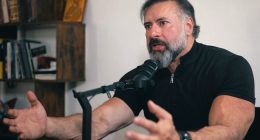IT’S fair to assume that Peter Gabriel doesn’t have a huge amount in common with ultimate big mouth Liam Gallagher.
For decades, as solo artist, soundtrack composer and human rights campaigner, the singer who began his musical journey with Genesis in the late Sixties has cut a calm, collected figure.

3

3
But I can report that he and Liam are partial to a contemptuous hand gesture which dates back to ancient Greece — the middle finger.
So let me explain its unlikely significance in the cerebral world of Peter Gabriel.
Throughout this year, at every full moon, he has released a song from i/o, a studio album more than 20 years in the making.
Each track has been accompanied by a striking image, commissioned by Gabriel, from a renowned visual artist.
In the case of Road To Joy, which tells of a person emerging from locked-in syndrome and near death, that artist is Chinese activist Ai Weiwei.
Against a bright pink background, white line drawings form a powerful pattern of raised middle fingers.
To mark the release of i/o in its entirety — 12 eclectic songs presented in three different mixes — I’ve had an illuminating email exchange with Gabriel, who provides this explanation.
“Besides being an inspirational artist, Ai Weiwei is an extraordinarily brave human rights campaigner,” he says.
“His oft-used motif of his middle finger is usually addressed to power and all its abuse, but in the context of this record, I see it as a middle finger salute to another power, death.”
Picking up on one of his album’s recurring themes, he continues: “At age 73, mortality creeps into the rear-view mirror. You either bring it to the front screen or run away from it.
“I am very interested in longevity research which I used to believe was a billionaires’ plaything but now see as a critical driver for all manner of medical breakthroughs for all of us.”
Gabriel was only 52 when his last studio album of original material appeared, 2002’s Up — and much of that was conceived in the Nineties.
He doesn’t want people getting “bored” or “oversaturated” with his work and so carries a certain mystique.
But now, re-energised, he’s back with i/o, some of the most compelling and accessible music of his storied career.
Ambitious as ever, he weaves together conventional instruments, sophisticated electronica, African-inspired rhythms, choirs and orchestras, topped off by his commanding vocal delivery undimmed by the passing years.
Since he left prog rock trailblazers Genesis in 1975, Gabriel has opened up new horizons in music and been an early adopter of the latest technology.
But, right from his first solo single, Solsbury Hill, he’s also been in thrall to nature.
It’s typical of him to choose the full moon to release his songs, asking fans to check the sky for when the next one is imminent.
Gabriel says: “If you look up at the stars, you get a good sense of where we belong. But we are getting so good at isolating ourselves from the natural world that created us. We tend to anchor our heads to a totally man-made environment.
“We are also entering the age of an additional virtual existence powered by AI, so the idea of remembering nature is important and natural landmarks like the moon and the passage of time seems to fit well to the themes of i/o.”
For the project, Gabriel reactivated his old Full Moon Club “in which I would talk to fans each full moon about what had been going on in my life.
“In some ways, this is just a continuation of that,” he reports.
Even if the seeds of i/o were sown years ago, the long-awaited follow-up to Up feels very much of the moment, capturing what’s on the singer’s mind right now.
Opener Panopticom flips the idea of 18th-Century philosopher and social reformer Jeremy Bentham, who designed a circular, multi-storey prison — a panopticon — in which all the occupants could be viewed by one guard situated in a central tower.
In Gabriel’s song, ordinary people can keep watch on those in power, thus turning mass surveillance on its head.
‘I wrote my mum a beautiful melody’
The Court suggests the justice system is a much abused but necessary part of civilised society. It comes with an earworm chorus,
“The court will rise/While the pillars all fall.”
Playing For Time is an old tune which has been performed live without lyrics but now cast as a rumination on getting older.
He decides that having “interesting experiences means richer memories to feed you when you get to my age”.
And Still is one of Gabriel’s most personal efforts, an affectionate, emotional tribute to his mother, who died in 2016.
For one of his filmed “deep dives” into i/o’s songs, he elaborates: “When my mum died, I wanted to do something for her, but it took a while before I felt comfortable and distant enough to be able to write something.
“In the middle, I wanted to write my mum a beautiful melody. She loved classical music, so we have a beautiful cello playing there.”
Though i/o incorporates sad and serious subjects, it still exhibits genuine joy in the music with closing track and final full moon release, the upbeat Live And Let Live, offering a message of hope for humanity through forgiveness.
The song draws inspiration from Gabriel’s involvement in The Elders movement, an independent group of global leaders founded by Nelson Mandela in 2007, “working for peace, justice, human rights and a sustainable planet”.
Live And Let Live features the Soweto Gospel Choir, a bold string arrangement and name checks “Madiba”, fellow Elder, Desmond Tutu and civil rights beacon Martin Luther King, Jr.
Gabriel also references the famous quote usually credited to Gandhi, “An eye for an eye makes the whole world blind.”
With conflict raging in the Middle East and Ukraine, his words, “When we forgive, we can move on”, have particular resonance, even if the protagonists might find them hard to accept right now.
Gabriel tells me: “One of the great privileges I have had in my life was to get to know and work with both Mandela and Tutu with The Elders.”
A member of the group’s advisory board, he adds: “I was so moved by Nelson Mandela’s description of when he came out of jail to become President of South Africa and stood next to some of those who had kept him in prison and been responsible for the death of many of his friends.

3
“He described how old feelings of fear and hate swelled up in him, but he realised that unless he could find a way to work with them, to build a different future with them, and ultimately to forgive them, he would remain their prisoner for the rest of his days.
“Although impossible now, this type of thinking may be the only hope for peace in the Middle East.”
Next, we move on to the soaring title track, i/o, which stands for input/output and is seen on various electronic devices.
The song is the product of an idea long percolating in Gabriel’s brain about everyone and everything on Earth being connected in some way.
Read Related Also: Madonna’s older brother Anthony Ciccone dead at 66
It includes the memorable lines, “Stuff coming out, stuff going in, I’m just a part of everything.”
Gabriel offers me this insight into his thinking: “In the West, we see ourselves as independent, self-determining individuals.
‘AI is about to turn world upside down’
“In many other cultures, humans are much more seen as part of the whole, as a part of everything.”
He believes the human race must take collective responsibility to deal with its challenges.
“We are now facing very real, existential problems and realistic, energetic optimism is the only possible way to tackle them,” he affirms.
“Defeatist pessimism never achieved anything, except possibly increased sales of alcohol.”
This brings him on to an existential threat of great concern to Gabriel (and the rest of us), Artificial Intelligence, a part of modern life he hopes we can turn to our advantage.
“AI is about to turn our world upside down and should be able to do all our jobs, including mine, better than we can,” he says.
“So we need to do some urgent thinking and brainstorming about how we can best live with each other and AI in the future.
“People talk of the ‘age of abundance’ and clearly that’s ridiculous for most people struggling to pay their bills but I do believe it’s coming if we can get through this difficult period of transition.”
It’s clear that forward-thinker Gabriel likes to see the bigger picture but, on a more personal note, the story of i/o wouldn’t be complete without all his amazing collaborators, a subject he tackles with relish.
I can’t remember an album with such a long list of credits including the three mixers Mark “Spike” Stent (Bright-Side Mix), Tchad Blake (Dark-Side Mix) and Hans-Martin Buff (In-Side Mix in Dolby Atmos).
Then there’s a fellow sonic pioneer, Brian Eno, who adds his singular flourishes to five songs, including “haunting synths” on Panopticom.
“I’ve always been lucky and smart enough to have surrounded myself with very talented people,” says Gabriel.
“Brian thinks like no one else and I always enjoy working with him. My job was to provide him with opportunities for pleasure without responsibility.”
Four Kinds Of Horses, which considers the roots of terrorism, began as Gabriel’s offering to a project by XL Records founder Richard Russell called Everything Is Recorded.
“Richard wanted me to generate some ideas with piano and voice,” he says.
“When he decided not to use what I had done, I felt I could shape it into something special and it evolved with a different chorus and groove into Four Kinds Of Horses.”
For the Tamla Motown- inspired This Is Home, Gabriel teamed up with American DJ and producer Skrillex.
He explains: “Skrillex approached me several years ago and we had a good exchange of ideas. Then he disappeared back into his normal world.
“I had started something that felt good, which I went on to build a song around. I tried a new twist on an old Tamla groove and soon the wheels were in place.”
Another name that appears several times in i/o’s credits is Gabriel’s musician daughter Melanie, who provides backing vocals.
He says: “I have always loved working with my kids and Melanie has such a gentle and soulful voice which really adds mood to some of my songs.”
Gabriel also spares a thought for Ríoghnach Connolly from folk duo The Breath who “has an amazing full and emotional voice. It was a real treat to work with her this time.”
Next he moves on to his orchestra arranger and conductor John Metcalfe, who helps give i/o such musical breadth and depth.
“I have worked with John for many years and we have a shorthand when communicating about arrangements.
“Often, we will talk through different approaches, but in the case of Road To Joy, it was entirely John’s wonderful and crazy idea.”
Then Gabriel honours the two choirs involved. “Orphei Drängar is an amazing Swedish male voice choir which produces dark, dreamy tones that you don’t hear elsewhere,” he says.
“And I have worked with the Soweto Gospel Choir several times. It’s a joy each time. I am always surprised by the passion and musicality of their performance.”
Finally, he turns his attention to visual artists who add extra dimension to each song.
Gabriel says: “I was a little apprehensive about whether some of my favourite artists would want to work with me.
“I was delighted at the number who said yes. Great visual work can open you up in many different ways than music alone.”
That includes Ai Weiwei’s life-affirming middle finger salute — Peter Gabriel’s way of saying “Up yours!” to the Grim Reaper.
Peter Gabriel’s I/O
4.5/5
1. Panoptico
2.The Court
3. Playing For Time
4. i/o
5. Four Kinds Of Horses
6. Road To Joy
7. So Much
8. Olive Tree
9. Love Can Heal
10. This Is Home
11. And Still
12. Live And Let Live
!function(f,b,e,v,n,t,s){if(f.fbq)return;n=f.fbq=function(){n.callMethod?
n.callMethod.apply(n,arguments):n.queue.push(arguments)};if(!f._fbq)f._fbq=n;
n.push=n;n.loaded=!0;n.version=’2.0′;n.queue=[];t=b.createElement(e);t.async=!0;
t.src=v;s=b.getElementsByTagName(e)[0];s.parentNode.insertBefore(t,s)}(window,
document,’script’,’
fbq(‘init’, ‘752905198150451’);
fbq(‘track’, “PageView”);







